| |
|
|
| Friendly
and unfriendly meetings in the Western Desert of Egypt: |
| |
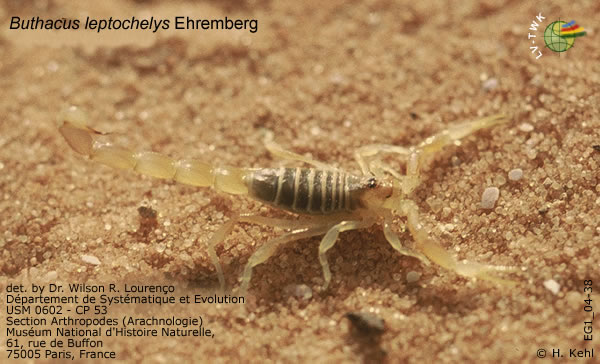
|
| |
 Abb.
D2-23/01
(oben): Abb.
D2-23/01
(oben):
Scorpion (Egyptian Green Scorpion) - Buthacus leptochelys
Ehremberg 1828:
E-Sahara / NW-Egypt / Mersa Matruh district
"This genus must be considered very cautiously by the keeper.
Indeed, since the Buthacus spp are extremely aggressive,
and belong to the Buthidae family, known for the dangerousness
of most of its members, keeping this genus is really inadvisable
to the beginners."
"5-6 cm. The adult of this species is uniformly yellow
(body, legs and metasoma).
Pectines of the female with 21 to 29 teeth, male's ones with
29 to 35 teeth."
The Scorpion Fauna [date of access
19.12.2006, now offline] |
| |
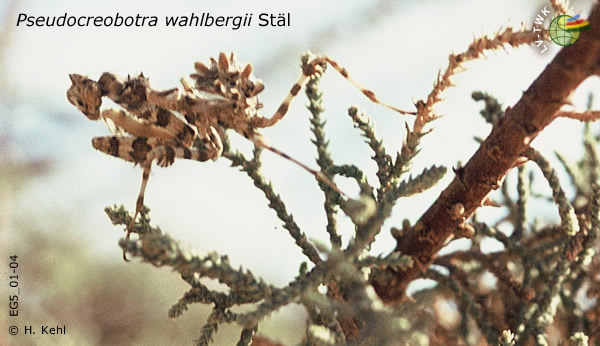 |
| |
 Abb.
D2-23/02
(oben): Abb.
D2-23/02
(oben):
Tanzania Flower Mantis - Pseudocreobotra wahlbergii Stäl
E-Sahara
/ Central-Egypt / near Dakhla oasis / Abu Tartur region
on Tamarix aphylla |
| |
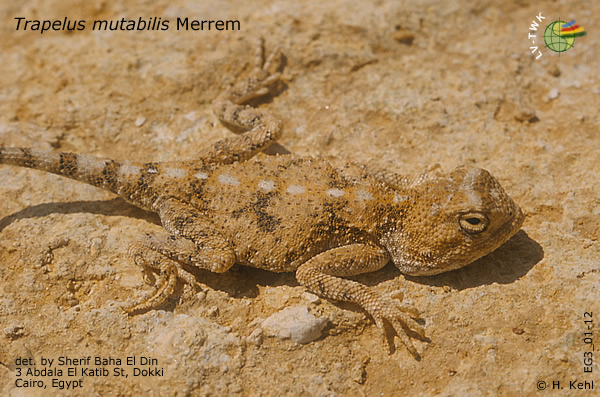 |
| |
|
 Abb.
D2-23/03
(oben): Abb.
D2-23/03
(oben):
Changeable, Desert or Toad Agama - Trapelus mutabilis
Merrem 1820:
E-Sahara / NW-Egypt / Mersa Matruh district / coastal area
For
detailled information cf. Baha El Din,
Sherif (2006) A Guide to the Reptiles and Amphibians of Egypt.-
Amer. Univ. in Cairo Press, 359pp.
|
| |
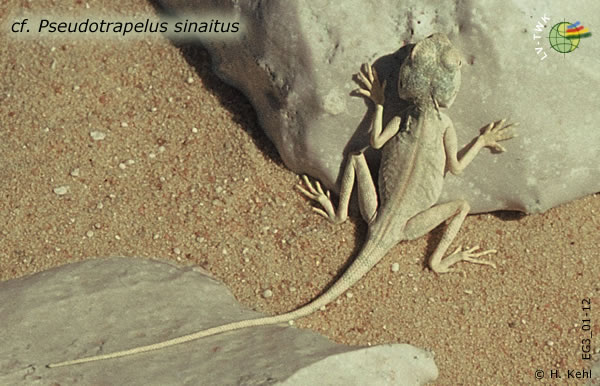 |
| |
|
 Abb.
D2-23/04
(oben): Abb.
D2-23/04
(oben):
Unknown Agama - cf. Pseudotrapelus sinaitus:
E-Sahara / Central-Egypt / Farafra district / White Desert
For
detailled information cf. Baha El Din,
Sherif (2006) A Guide to the Reptiles and Amphibians of Egypt.-
Amer. Univ. in Cairo Press, 359pp.
|
| |
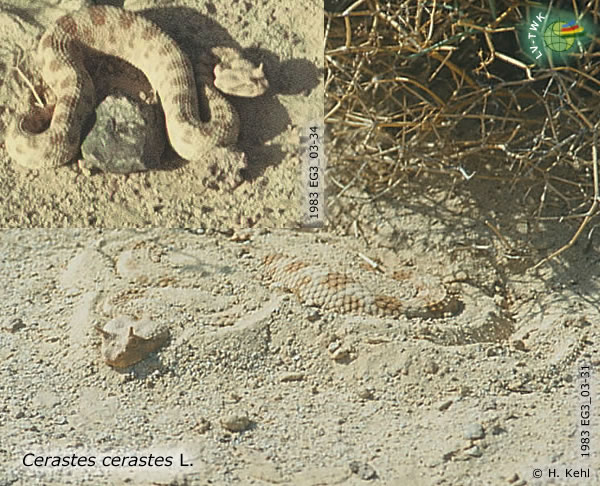 |
| |
|
 Abb.
D2-23/05
(oben): Abb.
D2-23/05
(oben):
Desert Horn-Viper - Cerastes cerastes L. 1798:
E-Sahara / NW-Egypt / Siwa district / Qattara Depression
"Cerastes cerastes is a venomous viper species
native to the deserts of Northern Africa and parts of the
Middle East. They are ore often easily recognized by the presence
of a pair of supraocular horns, although hornless individuals
do occur. No subspecies are currently recognized. [...]
C. cerastes venom is not very toxic, although it is
reported to be similar in action to Echis venom.[...] Envenomation
usually causes swelling, hemorrhage, necrosis, nausea, vomiting
and hematuria. A high phospholipase A2 content may cause cardiotoxicity
and myotoxicity[...]. Studies of venom from both C. cerastes
and C. vipera list a total of eight venom fractions, the most
powerful of which has hemorrhagic activity. Venom yields vary,
with anything from 19-27 mg dried venom to 100 mg being reported.[...]
An estimated lethal dose for humans is 40-50 mg."
Wikipedia
[date of access 19.12.2006]
|
| |
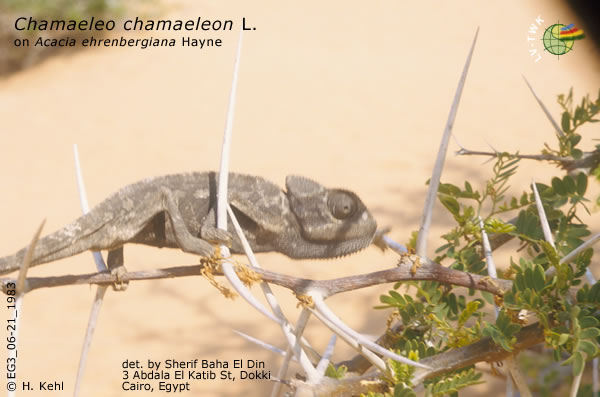 |
| |
|
 Abb.
D2-23/06
(oben): Abb.
D2-23/06
(oben):
Common or European Chameleon - Chamaeleo chamaeleon
L. 1758:
E-Sahara / NW-Egypt / Siwa district / Qattara Depression
"(The) small- to medium-sized lizard of the family Chamaeleonidae.
About eighty species are found in sub-Saharan Africa, with
a few in S Asia. The so-called common chameleon, Chamaeleo
chamaeleon, is found around the Mediterranean. Chameleons
have laterally flattened bodies and bulging, independently
rotating eyes. They are variously ornamented with crests,
horns, and spines. The toes are united into one bunch on either
side of the foot, forming a pair of grasping tongs. Chameleons
feed on small animals, chiefly insects, and they are unique
among lizards in possessing very long, sticky tongues with
which they capture their prey. Typical chameleons (members
of the very large genus Chamaeleo) are arboreal and have long,
prehensile tails. They move very slowly, with a rocking movement,
grasping a branch with feet and tail. The changes in skin
color, seen in certain other lizards as well, are under hormonal
and nervous control. They are not affected by the color of
the background but by stimuli such as light, temperature,
and emotion. However, the shades of brown, gray, and green
assumed by chameleons do generally blend with the forest surroundings.
The American chameleon, or anole (Anolis carolinensis), is
not a true chameleon, but a small lizard of the iguana family,
found in the SE United States and noted for its color changes.
True chameleons are classified in the phylum Chordata Chordata
(kôrda-`t?,–dä`–), phylum of animals
having a notochord, or dorsal stiffening rod, as the chief
internal skeletal support at some stage of their development."
ColumbiaFreeEncyclopedia
[date of access 19.12.2006]
For
detailled information cf. Baha El Din,
Sherif (2006) A Guide to the Reptiles and Amphibians of Egypt.-
Amer. Univ. in Cairo Press, 359pp.
|
| |
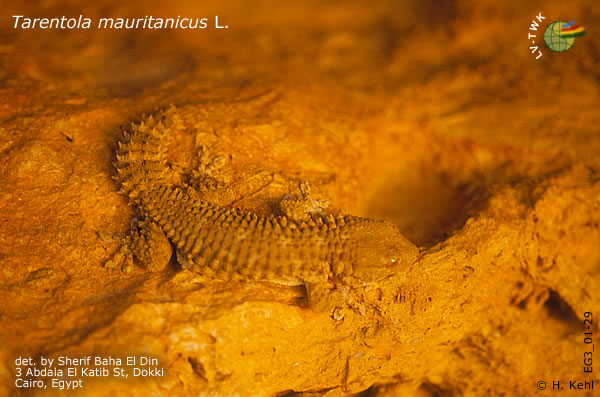 |
| |
|
 Abb.
D2-23/07
(oben): Abb.
D2-23/07
(oben):
Common Wall Gecko, Moorish Gecko, Crocodile Gecko -
Tarentola mauretanicus L.:
E-Sahara / NW-Egypt / Mersa Matruh district / coastal
area
Distribution: Costal Mediterranean Regions -
Portugal, Spain, Balearic Islands, Italy (incl. Lampedusa
island), Sardinia, France, Corsica, Malta, Madeira,
coastal Croatia (except Istria), Adriatic islands, Greece
(incl. Crete)
Morocco, Algeria, Tunisia, Libya, Egypt, Sinai, according
to GeckoList.com [date
of access 21.12.2006]
Remark:
Many thanks for cooperation to Dr.
Max Kasparek to determine the found species.
For detailled information cf. Baha
El Din, Sherif (2006) A Guide to the Reptiles and Amphibians
of Egypt.- Amer. Univ. in Cairo Press, 359pp.
|
| |
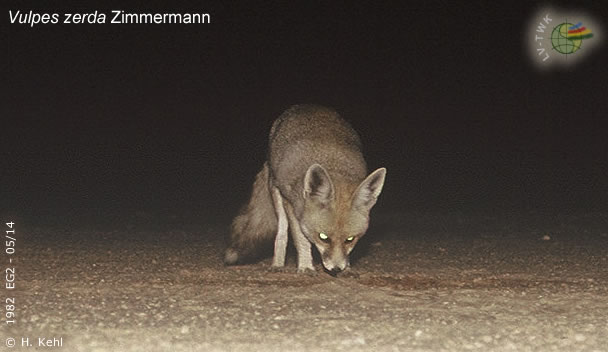 |
| |
|
 Abb.
D2-23/08
(oben): Abb.
D2-23/08
(oben):
Desert Fox or Fennec - Vulpes zerda Zimmermann
1780:
E-Sahara / C-Egypt / near oases
Geographic Range:
"The largest populations of Vulpes zerda occur
in the central Sahara, though the species can be found
in mountainous and desert regions from northern Morocco
(roughly 35 degrees N latitude), east along the northern
tip of the Red Sea to Kuwait, and south into northern
Nigeria and Chad (15 degrees N latitude)."
Habitat:
Fennecs are highly specialized to desert life and found
almost exclusively in arid, sandy regions. The presence
of desert grasses and/or light scrub vegetation is important,
as fennecs use these plants to bolster, shelter, and
line their dens. Fennecs are so well adapted to their
Saharan climate that they need not drink. In times of
need, however, nearby vegetation is a handy source of
water and may be eaten.
Physical
Description:
Fennecs are the smallest of the canids. They range in
size from 0.8 kg in vixens to 1.5 kg in males. They
are smaller than an average house cat. Tail length is
between 18 and 30 cm, and accounts for nearly 60 percent
of the 30 to 40 cm body length. Standing 18 to 22 cm
at the shoulder, fennecs are significantly shorter than
other African foxes, which average a shoulder height
of 30 cm. Not enough is known about fennecs to state
conclusively whether they are sexually dimorphic. The
family Canidae, however, exhibits the limited sexual
dimorphism common in groups of mostly monogamous species.
Since V. zerda is monogamous, it is reasonable
to assume this species follows the pattern of slight
sexual dimorphism. (...)
The
ears of fennecs are perhaps their most distinctive feature.
Massive in proportion to the skull, the large, 15 cm
long pinnae are used both to dissipate heat and to locate
prey moving under the sand. Enlarged auditory bullae
also serve this latter purpose. Fur in adults is thick
and silky, buff-colored on the dorsal surface and white
along the animal’s legs, face, ear-linings and
underside. In contrast, juveniles are downy and almost
exclusively white. The fur over the violet gland - found
in all foxes, and of unknown function - is black or
dark brown. This is also the color of the fur on the
tip of the tail. The feet are heavily furred, protecting
the pads from the hot desert sand. The eyes, rhinal
pad, and vibrissae of fennecs are all black. Dentition
is weak, similar to that in bat-eared foxes. (...)
Ecosystem
Roles:
Fennecs are predators, reducing the number of small
mammals, birds, reptiles, insects, and other terrestrial
invertebrates found within their home territories. They
may strip the leaves off scrub vegetation, but there
is no evidence that this behavior causes permanent damage
to the plants."
Information
provided in the Internet by Rebecca
Adams
Animal Diversity Web - University of Michigan Museum
of Zoology
[date of access 21.12.2006]
|
| |
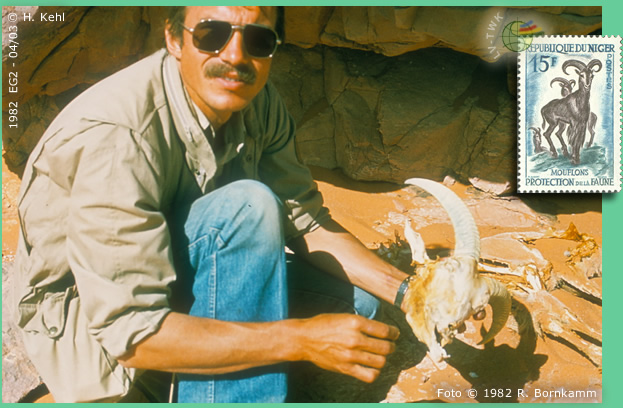 |
| |
 Abb.
D2-23/09
(oben): Abb.
D2-23/09
(oben):
Barbary Sheep, Aoudad or Arui - Ammotragus lervia
Pallas 1777 cf. ssp. ornatus:
E-Sahara / SW-Egypt / Gilf Kebir - only dead animals were
found in 1982
"General Characteristics:
Body
Length: 130-165 cm / 4.3-5.5 ft.
Shoulder Height: 75-110 cm / 2.5-3.7 ft.
Tail Length: 15-20 cm / 6-8 in.
Weight: 30-145 kg / 66-319 lb.
The short, bristly outer coat is reddish to sandy brown
in colour. The underparts are moderately lighter. Both
sexes have a heavy fringe of hair on their throat, although
in males this extends down the neck to encompass the
chest and front legs. The tail is also fringed. The
body is quite thick and sturdy. The thick, triangular-based
horns are found in both sexes, although they are slightly
larger in males. The horns have numerous fine rings,
although in older individuals these may be worn down,
causing the horn surface to look smooth. They curve
in a semi-circle over the back, up to 55 cm / 22 inches.
Ecology
and Behavior:
Like most desert dwellers, the aoudad is most active
in the cooler hours of dawn and dusk, seeking shade
and shelter during the day. Aoudad are exceptionally
sure-footed and have such jumping power that they can
clear a 2 meter / 6.6 foot obstacle with ease from a
standing start. The lack of vegetation for cover in
their habitat has caused the aoudad to conceal itself
by freezing in the presence of danger. Although they
can generally obtain all needed moisture from their
food, if water is available aoudad drink and wallow
liberally.
Family group: Generally solitary or in small groups.
Diet: Sparse grasses, bushes, acacia, lichens.
Main Predators: Leopard, caracal.
Distribution:
Rocky arid mountains in isolated pockets throughout
northern Africa.
Conservation
Status:
The aoudad is classified as a vulnerable species by
the IUCN (1996). A. l. ornatus, the Egyptian
barbary sheep, is believed to be extinct."
Information
provided on Ammotragus laervia in the Internet
by Brent Huffman
www.ultimateungulate.com
[date of access 21.12.2006]
|
| |
| |
 |
| |
|
Copyright
© H. Kehl
Ehemals TU-Berlin - Institut für Ökologie
|
| |



|
| |
|
|
|
| |
| |
| |
| |
|
|
|